There is always a ton of talk on car forums about mono-tube vs twin-tube and coil-over vs spring-shock and I figured I would go ahead and post my thoughts on the subject given what I have learned over years of both street tuning and racing.
I was going to post a long thread about this but I think Tein does a better job then I ever could do but I want to add a few additions on the subject.
However, I would like to add a few important things for you to keep in mind before you read the article from Tein. After reading this article my respect for Tein has jumped about 100 fold since they seem to be the only company that tries to really inform customers.
The first thing is this article really keeps in mind the best possible scenario for mono-tube shocks. I want to add that not all mono-tubes are built the same because they have different goals to achieve. However, what it doesn't tell you is that mono-tubes have some serious downsides for the street that I think should be addressed. The first is that cheap mono-tube solutions Bilstein/KYB shocks or cheap coil-overs is that they are built for the street.
This means they need work over a long period of time compared to a racing shock. The average racing shock gets re-pressured at the very least before every racing weekend so they might need to work at optimal levels for a few days. The street mono-tube must work at optimal levels for years meaning that gas pressure has to be retained inside the floating piston. To do this they have to run significant amount of sealing on the floating piston so they shock will be durable to street use. The downside to this is that a floating piston with high sealing surface friction or stiction significantly reduces the shocks ability to deal with small amplitude and high frequency response and this is the real reason they ride so rough. The cheap mono-tube also runs high pressure. I have read that bilstein runs around 360lbs of pressure in there shocks. In a racing shock from AST or Moton on the track I run usually between 100-200lbs of pressure so you can see its almost double a racing shock. This means that resistance inside the oil is going to be higher and we see this on some racing shocks (Penske) but keep in mind they are valved for it. Bilstein does it so the shock will last longer and to keep the shock working relatively decently over the large pressure change the shocks will see during there lifetime they use divergent valving. This amazingly is the real reason for divergent valving and its a damn impressive solution but its not the advertising they would like you to believe. The mono-tube life span even with all the extra seal friction and pressure is about three years and given all the drawbacks that these shocks and coil-overs deal with I always suggest a different solution for street cars. Also, since these shocks usually don't work as good as a twin-tube even on the track I usually suggest going with a twin-tube setup unless you have the budget to spring for a higher end coilover with nitrogen port so you can enjoy them for a very long time.
Anyways for the following all credit goes to Tein and here is the link.
TEIN, INC. | SPECIAL | Why TEIN is "Mono-Tube / Twin-Tube Construction"
The structural differences between Mono-tube and Twin-tube.
These are the Mono-tube and Twin-tube shock absorbers you often find in magazines etc.
For those of you who have ever thought to yourself, “I think I know the differences in the structure, but what exactly is the difference?” Here is the explanation.
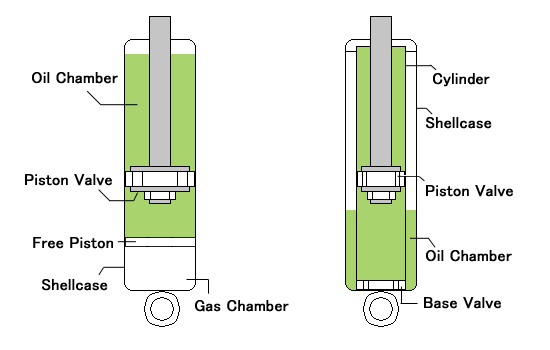
The main difference between Mono-tube and Twin-tube systems, as shown above, is the number of tubes used for the shock absorber.
♦ Mono-tube: the shell case itself works as a cylinder and oil, gas, piston valve, etc are all set in a single tube.
♦ Twin-tube: there is a separate cylinder set inside the shell case and the piston valve moves up and down within the inner cylinder.
Other differences in construction.
Mono-tube uses a free piston that completely separates the oil chamber from the gas chamber. While for the Twin-tube, nothing separates the oil and gas chambers within the shell case.
The differences between Mono-tube and Twin-tube shock absorbers, is not simply the number of tubes but also the inner mechanism as well.
Let’s have a look at the merits and demerits of the mono-tube shock absorber.
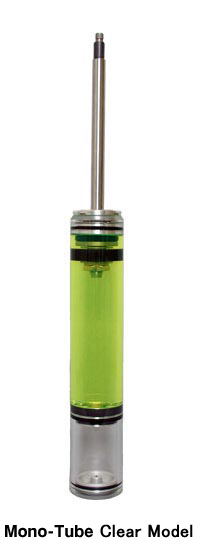
Merits
*Stable damping force can be generated, because of the larger oil capacity and improved heat dissipation.
*The larger sized piston valve creates a wider area to receive pressure, and even subtle damping force can be achieved.
*The structure allows no restrictions in installation angles.
*Oil radiates heat easier as the temperature increases.
*Aeration doesn’t occur because oil and gas are completely separated.
Demerits
*Maintaining sufficient stroke is difficult because the oil and gas chambers are positioned serially.
*Due to the high-pressure gas injection structure, there is a tendency for a stiffer ride.
*Due to high-pressure gas injection, high stress is put on seals and friction increases.
*Compared with the upright type, the inverted type tends to have more friction, because it has more moving parts with one stroke.
*If the shell case is damaged, the inner cylinder is directly affected.
Let’s have a look at the merits and demerits of the twin-tube shock absorber.
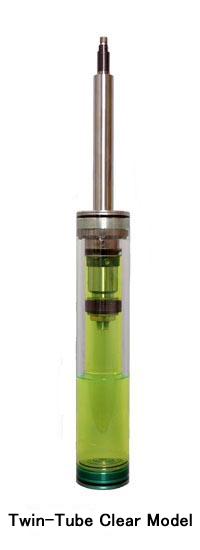
Merits
*It is easier to secure sufficient stroke, because the oil and gas chambers are separated and not positioned serially.
*The base valve enables to keep gas pressure low, allowing for a more comfortable ride.
*Low gas pressure avoids stress on seals and keeps friction levels low.
*Compared to the inverted type, friction can be suppressed.
*Even if the shell case is slightly damaged, the function of the shock absorber remains unaffected.
*Superior manufacturing processes allow to keep production costs low.
Demerits
*Oil capacity is not as large as the mono-tube.
*Size of the piston valve is not as large as the mono-tube.
*The structure restricts installation angles.
*The oil and gas chambers are not separated, so there is a possibility for aeration to occur.
Did you understand the merits and demerits of the mono and twin-tubes?
Now, let’s directly compare the mono and twin-tubes.
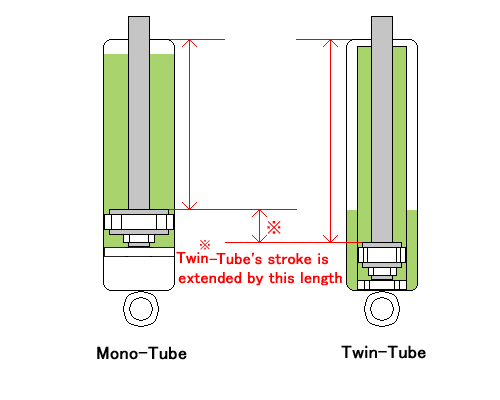
1. Ride quality of street shock absorber.
Some manufacturers say the mono-tube is superior to the rest, but is it really true?
Let’s take a look back at the demerits of the mono-tube.
*Maintaining sufficient stroke is difficult because the oil and gas chambers are positioned serially.
* Due to the high-pressure gas injection structure, there is a tendency for a stiffer ride.
*Due to high-pressure gas injection, high stress is put on seals and friction increases.
*Compared with the upright type, the inverted type tends to have more friction, because it has more moving parts with one stroke.
*If the shell case is damaged, the inner cylinder is directly affected.
In recent years, the importance of ride quality has become essential for street shock absorbers.
To ensure optimal ride quality with street shock absorbers, it is vital to have the correct settings, but also sufficient stroke.
Within the mono-tube, oil and gas chambers are divided and distributed serially, and when comparing it with the same length twin-tube, it can not ensure sufficient stroke.
If you have a race shock absorber, designed for flat surfaced circuits, you don’t require as much stroke length as a street shock absorber, which has to deal with uneven surfaces and other conditions.
There is a direct link in experiencing deteriorated ride, such as sudden jolts etc, for street shock absorbers and not securing sufficient stroke.
2. What is the high-pressure gas ?
Similar to the insufficient stroke problem, the high-pressure gas injection creates a stiffer ride, enlarges friction etc. and is the main reason for deteriorating ride quality.
Some manufacturers have the base valve positioned above the free piston to lower the high-pressure gas injected. But this results in even further sacrifice in stroke space and a tendency to reverse the effect.
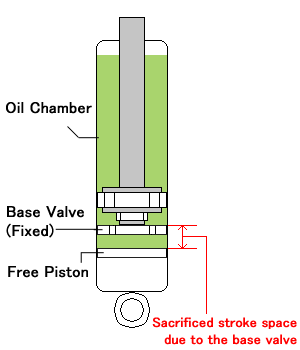
【Reference】 Why the mono-tube requires high pressure gas injection.
The twin-tube shares and creates the expanding/ contracting damping force with the piston and base valves, so there is no need for high-pressure gas injection.
However, the mono-tube creates the expanding/ contracting damping force with just the piston valve.
The mono-tube stroke action occurs when the free piston moves in the space created by the contracting piston rod. During this action, if there isn’t enough pressure on the free piston, it will easily move, over contracting and accurate contracting damping force will not be achieved.
For this reason, there needs to be enough high-pressure gas injected into the gas chamber to control the free piston.
When you inject high-pressure gas into the gas chamber, according to Pascal’s law, there will be an equal amount of gas pressure supplied to the amount of shock sustained. When this happens there will be high pressure applied on the oil seal, and the restraining force on the seal will increase therefore also increasing friction.
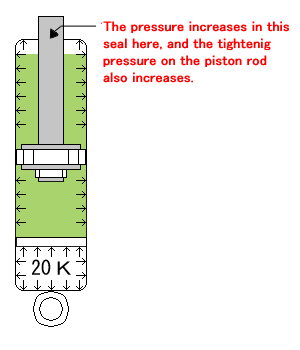
When there is low gas pressure.

When there is appropriate gas pressure

3. Which is better suited for the street ?
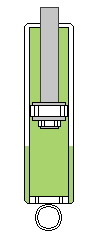
You never know what is lying on the surface of a regular road.
If something strikes the shock absorber and damages the shell case, the mono-tube, which is constructed of only one inner cylinder, will not be able to perform its stroke action.
If you think about it, can you really say the mono-tube design is optimal for the street?
I'm afraid the answer is "NO".
Let's take a look back at the merits of the twin-tube.
*It is easier to secure sufficient stroke, because the oil and gas chambers are separated and not positioned serially.
*The base valve enables to keep gas pressure low, allowing for a more comfortable ride.
*Low gas pressure avoids stress on seals and keeps friction levels low.
*Compared to the inverted type, friction can be suppressed.
*Even if the shell case is slightly damaged, the function of the shock absorber remains unaffected.
The twin-tube design can answer all the street shock absorber problems. Furthermore, if you compare it with the mono-tube, it has lower costs due to superior manufacturing processes.
Other extremely important factors are high quality and reasonable price.
In other words, the optimal design for the street is the twin-tube.
4. Mono-tube for the Circuit.
Next let’s compare them for the circuit. For the street, the mono-tube’s demerits stand out, but on the circuit, its full potential is exhibited.
Let’s take a look back at the merits of the mono-tube.

*Stable damping force can be generated, because of the larger oil capacity and improved heat dissipation.
*The larger sized piston valve creates a wider area to receive pressure, and even microscopic damping force can be achieved.
*The structure allows no restrictions in installation angles.
*Oil radiates heat easier as the temperature increases.
*Aeration doesn’t occur because oil and gas are completely separated.
For the shock absorber, racing on a circuit is an extremely rigorous environment.
When racing continuously for long hours, the shock absorber, itself will generate a lot of heat. The nearby brake gives off even more, generating heat close to 1000 degrees. The shock absorber feels the full effects of this heat.
For this reason, even when driven hard for long hours, it is vital for circuit shock absorbers to perform consistently. So it’s the mono-tube’s merits that are naturally suited for hard driven circuits.
The stroke problem is not really a concern at the circuit because the flat surfaces and high spring rates don’t require as much stroke action as on the street.
This is why the mono-tube design is better suited for the circuit.
The twin-tube design....
*Structurally, the oil capacity is lower than the mono-tube.
*Structurally, the piston valve cannot be larger than that of the mono-tube.
*Structurally, the shell case cannot be inverted for strut type suspension.
*Aeration may occur because the oil and gas chambers are not separated.
Unfortunately we cannot say that it is suited for the hard circuit conditions because of these demerits.
But when we say the twin-tube is not suited for circuits, it is only based on direct comparisons with the mono-tube.